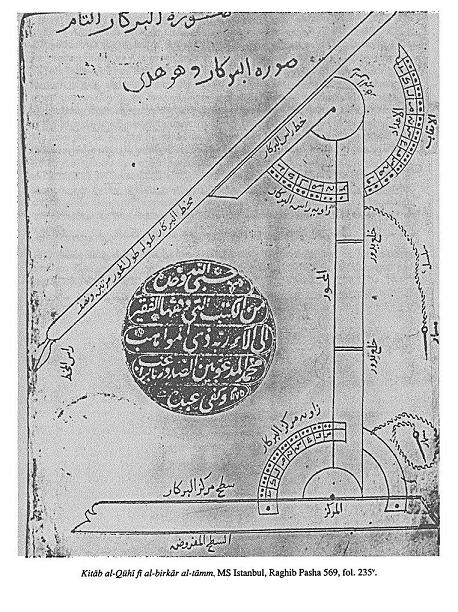Abū Sahl Al-Qūhī on:
[Wikipedia]
[Google]
[Amazon]
(; fa, ابوسهل بیژن کوهی ''Abusahl Bijan-e Koohi'') was a  Al-Qūhī was the leader of the astronomers working in 988 AD at the observatory built by the Buwayhid amir
Al-Qūhī was the leader of the astronomers working in 988 AD at the observatory built by the Buwayhid amir
Persian
Persian may refer to:
* People and things from Iran, historically called ''Persia'' in the English language
** Persians, the majority ethnic group in Iran, not to be conflated with the Iranic peoples
** Persian language, an Iranian language of the ...
mathematician
A mathematician is someone who uses an extensive knowledge of mathematics in their work, typically to solve mathematical problems.
Mathematicians are concerned with numbers, data, quantity, structure, space, models, and change.
History
On ...
, physicist
A physicist is a scientist who specializes in the field of physics, which encompasses the interactions of matter and energy at all length and time scales in the physical universe.
Physicists generally are interested in the root or ultimate cau ...
and astronomer
An astronomer is a scientist in the field of astronomy who focuses their studies on a specific question or field outside the scope of Earth. They observe astronomical objects such as stars, planets, moons, comets and galaxies – in either ...
. He was from Kuh (or Quh), an area in Tabaristan
Tabaristan or Tabarestan ( fa, طبرستان, Ṭabarestān, or mzn, تبرستون, Tabarestun, ultimately from Middle Persian: , ''Tapur(i)stān''), was the name applied to a mountainous region located on the Caspian coast of northern Iran. ...
, Amol, and flourished in Baghdad
Baghdad (; ar, بَغْدَاد , ) is the capital of Iraq and the second-largest city in the Arab world after Cairo. It is located on the Tigris near the ruins of the ancient city of Babylon and the Sassanid Persian capital of Ctesiphon. I ...
in the 10th century. He is considered one of the greatest geometers, with many mathematical and astronomical writings ascribed to him.
 Al-Qūhī was the leader of the astronomers working in 988 AD at the observatory built by the Buwayhid amir
Al-Qūhī was the leader of the astronomers working in 988 AD at the observatory built by the Buwayhid amir Sharaf al-Dawla
Shirdil Abu'l-Fawaris ( ar, شيردل أبو الفوارس) (c. 960-September 7, 988 or September 6, 989) was the Buyid amir of Kerman and Fars (983-988/9), as well as Iraq (987-988/9). He was the eldest son of 'Adud al-Dawla.
Early life
Wh ...
in Badhdad. He wrote a treatise on the astrolabe in which he solves a number of difficult geometric problems.
In mathematics he devoted his attention to those Archimedean and Apollonian problems leading to equations higher than the second degree. He solved some of them and discussed the conditions of solvability. For example, he was able to solve the problem of inscribing an equilateral pentagon
In geometry, an equilateral pentagon is a polygon in the Euclidean plane with five sides of equal length. Its five vertex angles can take a range of sets of values, thus permitting it to form a family of pentagons. In contrast, the regular pe ...
into a square, resulting in a fourth degree equation. He also wrote a treatise on the "perfect compass", a compass with one leg of variable length that allows users to draw any conic section
In mathematics, a conic section, quadratic curve or conic is a curve obtained as the intersection of the surface of a cone with a plane. The three types of conic section are the hyperbola, the parabola, and the ellipse; the circle is a spe ...
: straight line
In geometry, a line is an infinitely long object with no width, depth, or curvature. Thus, lines are one-dimensional objects, though they may exist in two, three, or higher dimension spaces. The word ''line'' may also refer to a line segmen ...
s, circle
A circle is a shape consisting of all points in a plane that are at a given distance from a given point, the centre. Equivalently, it is the curve traced out by a point that moves in a plane so that its distance from a given point is con ...
s, ellipses, parabola
In mathematics, a parabola is a plane curve which is Reflection symmetry, mirror-symmetrical and is approximately U-shaped. It fits several superficially different Mathematics, mathematical descriptions, which can all be proved to define exact ...
s and hyperbola
In mathematics, a hyperbola (; pl. hyperbolas or hyperbolae ; adj. hyperbolic ) is a type of smooth curve lying in a plane, defined by its geometric properties or by equations for which it is the solution set. A hyperbola has two pieces, ca ...
s. It is likely that al-Qūhī invented the device.
Like Aristotle
Aristotle (; grc-gre, Ἀριστοτέλης ''Aristotélēs'', ; 384–322 BC) was a Greek philosopher and polymath during the Classical period in Ancient Greece. Taught by Plato, he was the founder of the Peripatetic school of ph ...
, al-Qūhī proposed that the weight
In science and engineering, the weight of an object is the force acting on the object due to gravity.
Some standard textbooks define weight as a vector quantity, the gravitational force acting on the object. Others define weight as a scalar qua ...
of bodies varies with their distance from the center of the Earth.
The correspondence between al-Qūhī and Abu Ishaq al-Sabi, a high civil servant interested in mathematics, has been preserved.M. Steinschnieder, ''Lettere intorno ad Alcuhi a D. Bald''. Boncompagni (Roma, 1863)
References
Further reading
* {{DEFAULTSORT:Qūhī, Abu Sahl 1000 deaths 10th-century Iranian mathematicians People from Amol 10th-century Iranian astronomers Scholars under the Buyid dynasty 10th-century people from the Abbasid Caliphate